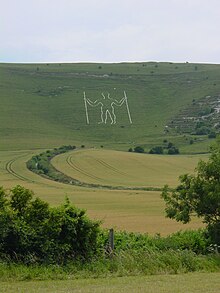50°48′36″N 0°11′17″E / 50.810°N 0.188°E
 The Long Man of Wilmington | |
| Alternative name | Wilmington Giant |
|---|---|
| Location | Windover Hill, Wilmington, East Sussex, England |
| Coordinates | 50°48′36″N 0°11′17″E / 50.810°N 0.188°E |
| Type | Hill figure monument |
| Length | 72 m (235ft) |
| History | |
| Material | Chalk |
| Founded | First recorded 1710 |
| Associated with | |
| Site notes | |
| Ownership | Sussex Archaeological Society |
| Public access | Yes |
| Designated | 1 May 1951 |
| Identifiers | |
| NHLE | 1002293 |
The Long Man of Wilmington or Wilmington Giant is a hill figure on the steep slopes of Windover Hill near Wilmington, East Sussex, England. It is 6 miles (9.7 km) northwest of Eastbourne and 1⁄3 mile (540 m) south of Wilmington. Locally, the figure was once often called the "Green Man".[1] The Long Man is 235 feet (72 m) tall,[2] holds two "staves", and is designed to look in proportion when viewed from below.
Formerly thought to originate in the Iron Age or even the neolithic period, a 2003 archaeological investigation showed that the figure may have been cut in the Early Modern era – the 16th or 17th century AD. From afar the figure appears to have been carved from the underlying chalk; but the modern figure is formed from white-painted breeze blocks and lime mortar.[3]
The Long Man is one of two major extant human hill figures in England; the other is the Cerne Abbas Giant, north of Dorchester. Both are Scheduled Monuments. Two other hill figures that include humans are the Osmington White Horse and the Fovant regimental badges.
The Long Man is also one of two hill figures in East Sussex; the other is the Litlington White Horse, 3 miles south-west of the Long Man.
- ^ Castleden, Rodney (2002). "Shape-shifting: The changing outline of the Long Man of Wilmington" (PDF). Sussex Archaeological Collections. 140 (140): 85. doi:10.5284/1085966.
- ^ "Long Man cleaned up for May Day". BBC News. 29 April 2007. Retrieved 2 August 2023.
- ^ "The Long Man of Wilmington". Sussex Past. Sussex Archaeological Society. Retrieved 22 August 2023.
